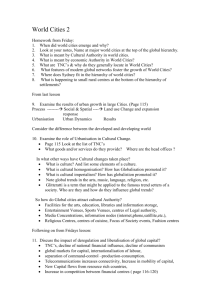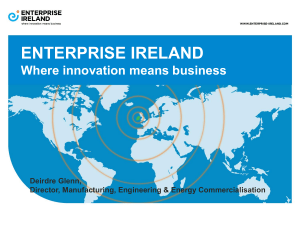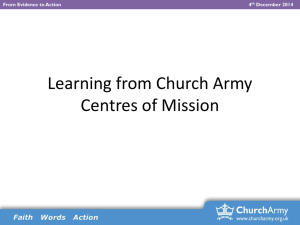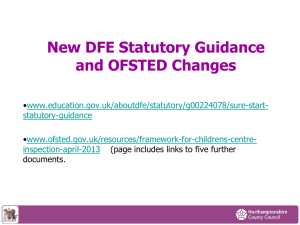Human Resource Management in the Service Sector
advertisement
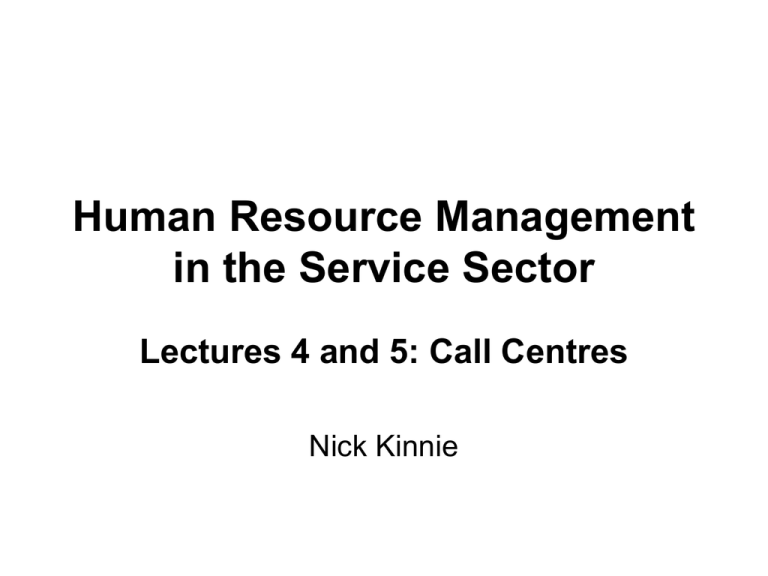
Human Resource Management in the Service Sector Lectures 4 and 5: Call Centres Nick Kinnie Objectives • Define call centres and understand the reasons for their growth • Identify the key characteristics of the nature and management of call centres • Analyse their forms of human capital and consider the implications for HR especially recruitment, selection and retention • Examine recent changes in call centres especially the moves towards outsourcing and off-shoring • Apply the 4 ID model to gain insights into the nature of work in call centres (Refs: Deery and Kinnie, 2004; Korczynski, 2002, Frenkel et al, 1999, Homan, 2004) Introduction • Call centres are… – Fast growing and important sources of employment – Subject to controversy and attention – customer service and movement of jobs • and can be defined as… – – – – Dedicated centres engaged in voice-to-voice contact CSRs interact directly with customers Involve use of sophisticated computer based systems Monitoring the pace and quality of their work Call centre images…. • They can be found in… – Private sector – customer service, sales and telemarketing – Public sector – information, advice and support • In different locations… – In-house – Outsourced – Off-shored • And involve… – In-bound and outbound work Why have they grown? Pressures on call centres Product market Customers and clients Call centre Financial success – short and long term (Maister, 2003) Employment market – needs of employees Nature of call centre work: contrasting views • ‘Assembly line in the head’ (Taylor and Bain, 1999) – Engineering/manufacturing model dominates – Jobs are divided up into small tasks which are repeated – Technology exerts a powerful influence especially in allocating work – Work is tightly controlled and routinised – use of scripts Manufacturing model – Target setting, monitoring, measurement and feedback of both quantitative and qualitative (customer based) criteria – Aim is to reduce skill level, improve efficiency and simplify procedures – Leads to low skill, low pay jobs with few career prospects Critiques of the engineering model • Employees are the key point of contact – voice of the firm and quality of their service is critical • Employees often need to exercise some discretion and be able to draw on variety of knowledge and skills • Customer involvement always leads to some element of unpredictability • (Frenkel, 1999) Service model • Firms use a series of HRM techniques in order to manage their employees – Careful recruitment and selective employment – Attention to training and development – especially coaching – Sensitive performance management paying attention to employee needs – Pay systems which are consistent with aims of the business Contradictions in call centre work • Call centres have to be both efficient and provide a high quality service • Both logics are important • Customer oriented bureaucracy (Korczynski, 2002) • ‘Fun and Surveillance’ (Kinnie et al, 2000) • Segmentation of customers and of employees (Batt, 2002) CSR-customer interactions Links between CSR-customer interactions, HR practices and business performance High Relationship Management Business performance Pseudorelationship Low Transaction HR practices Cost minimisation High Commitment Management Impact on employees • Acknowledgement that employees play a key role in the delivery of the service – ‘the voice of the brand’ • Engage in emotional labour – expressing or suppressing emotions that they feel or do not feel • Low autonomy and close supervision and monitoring associated with increased stress, burnout and emotional exhaustion – reduced employee well-being • Effect on work-life balance – time and length of working hours Employee reactions and responses • Negative – Employee withdrawal from work – temporary or permanent – Various forms of resistance – manipulating the system to create ‘space’, disregarding the rules – Collective organisation – trade unionism • Positive – Satisfaction from interaction with customers and peer groups – Acceptance of performance monitoring – Well-being in some call centres compares favourably with sales and manufacturing work (Holman, 2004) Analysing call centres using the forms of capital/reactor model • Use the reactor model to highlight the forms of capital within call centres • Which are the most important forms of capital? • How do they interact? • What are the implications of this for HR practices especially recruitment, selection and retention? Knowledge skills and experience of staff Forms of Capital Knowledge of and relationships with network members Human capital Social capital Network Capital Intellectual Capital Knowledge of and relationships with clients Client Capital Knowledge embedded in values, culture and relationships Structural capital Organizational Capital Procedures, policies and processes Ways of structuring work The HR Wheel Resourcing Human capital Social capital Network Capital Intellectual Capital Client Structural Capital capital Organizational Capital Pay and Reward Kinnie et al 2006 Delivery Types of call centres • In-house – part of a wider organisation • Outsourced – giving some or all of the work to a third party • Off-shore – where the work is carried out remotely – may be directly owned, joint venture or third party Why outsource/off-shore call centre work? • Reduce costs • Improve efficiency • Provide a buffer against demand fluctuations • Give access to specialist knowledge and skills Multiple sources of identity • What are the key sources of identity in call centres? • Which of these exert the most powerful pull on employees? • What are the implications of this for HR practices? • How can this analysis help us to understand the HR issues within the Norwich Union call centres? Multiple sources of identity Organisation Professional Employee Team Client Conclusions • Call centres are growing but face a series of conflicting pressures and tensions • The reactor and 4 ID model can provide insights into the sources of these • HR issues are often at the centre of these pressures, especially recruitment, selection and retention


